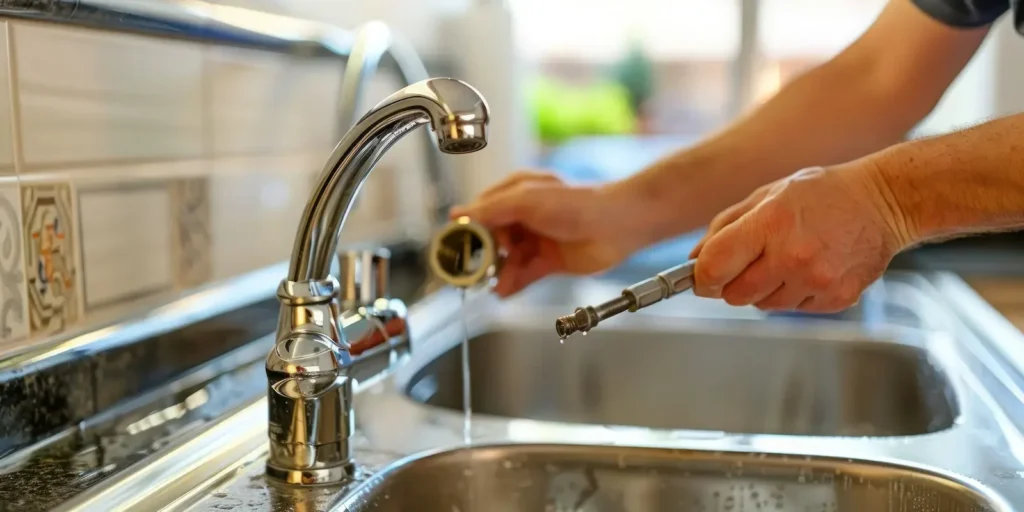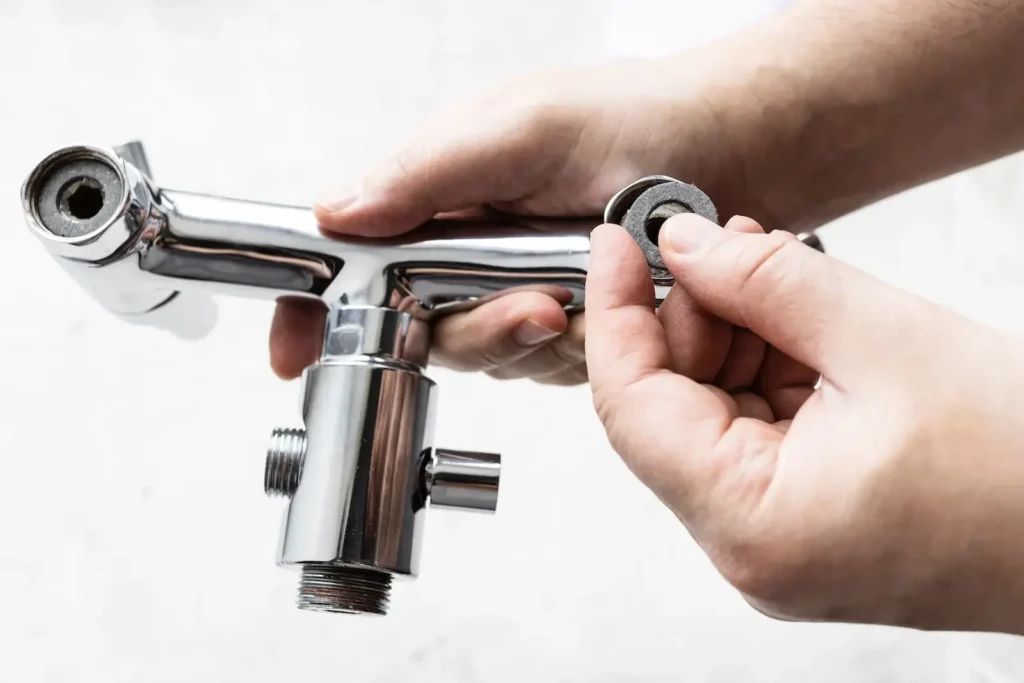That darn leaky faucet! It’s like a fly in the buttermilk or a mosquito buzzing in your ear at night. It’s enough to drive you crazy, while also potentially driving up your water bill or damaging your sink and countertops.
Stopping a leaky faucet is fairly simple: disassemble the faucet, identify the faulty piece, fix it and re-assemble. But sometimes there are some additional nuances we need to pay mind to. In this guide, we’ll explore the common causes of dripping faucets, how to fix a leaky faucet, and when it’s best to call in a professional.
And if you find yourself needing a helping hand, remember your friendly neighborhood plumbers at Johnny Rooter are just a call away. As a second-generation family business local to Austin, we’re not just experts in leaky faucet repair, we’re also your neighbors, and we’re always happy to lend our expertise to help folks in our community.

Why Do Faucets Leak or Drip?
That incessant drip, drip, drip coming from your faucet does more than just drive you out of your ever lovin’ mind. A dripping faucet can waste water, increase your water bill, and even cause damage to your sink or countertops over time. But why do faucets leak in the first place? There are several common culprits:
- Worn-out washers: Washers are small but mighty components that create a seal to prevent water from flowing when the faucet is turned off. Over time, these washers can wear out, crack, or become dislodged, leading to leaks. This is often the cause of a slow drip. If you’re wondering “why is my faucet dripping?” a worn washer is a good place to start your investigation.
- Corroded valve seats: The valve seat is the part of the faucet where the washer sits. Corrosion or mineral buildup on the valve seat can prevent the washer from forming a tight seal, causing drips and leaks.
- Damaged O-rings: O-rings are small rubber rings that help seal different parts of the faucet. If an O-ring is damaged or worn, it can cause leaks around the handle or base of the faucet.
- Loose parts: Sometimes, a leaky faucet is simply a matter of loose screws or connections within the faucet assembly. Checking for loose parts is a good first step in troubleshooting a “dripping faucet.”
- High water pressure: While less common, excessive water pressure can put stress on faucet components, leading to leaks.
Understanding the potential causes of a leaky faucet can help you troubleshoot the problem and determine whether it’s a simple DIY fix or if you need to call in a professional plumber.
Single Handle vs. Double Handle: Does it Affect Leaks?
Believe it or not, the type of faucet handle you have – single or double – can actually influence the likelihood of leaks and how those leaks are repaired. Here’s a breakdown:
Single-Handle Faucets
- Mechanism: Single-handle faucets use a cartridge that controls both water volume and temperature. This cartridge has moving parts and seals that can wear down over time.
- Wear and Tear: Since one handle controls both flow and temperature, the cartridge experiences more frequent use and is more prone to wear and tear, which can lead to leaks.
- Hard Water Impact: Hard water, common in Austin, can exacerbate wear on the cartridge, as mineral deposits can build up and affect the seals.
Double-Handle Faucets
- Mechanism: Double-handle faucets have separate valves for hot and cold water, each with its own set of washers and seals.
- Less Wear: Each handle controls only one function (hot or cold), so the individual valves and washers experience less wear and tear compared to a single-handle cartridge.
- Easier to Repair: If a leak occurs in a double-handle faucet, it’s often easier to pinpoint and repair the specific valve causing the problem. This can be helpful when figuring out “how to fix a leaky faucet with two handles.
Which is More Prone to Leaks?
While both types can develop leaks, single-handle faucets might be slightly more susceptible due to the increased wear and tear on the cartridge. However, the quality of the faucet, frequency of use, and water conditions also play significant roles.
Repair Considerations
- Single-handle: Repairing a single-handle faucet often involves replacing the entire cartridge.
Double-handle: Repairing a double-handle faucet usually involves replacing the washer or O-ring in the faulty valve.

How to Stop a Leaky Faucet in 7 Easy Steps:
Ready to tackle that leaky faucet repair yourself? Here’s a step-by-step guide to help you stop that annoying drip:
1. Turn Off the Water Supply
Before you begin any faucet repair, it’s crucial to turn off the water supply to avoid any unexpected sprays. Locate the shut-off valves under your sink – they’ll be connected to the hot and cold water lines. Turn them clockwise to shut off the water. If you don’t have individual shut-off valves, you’ll need to turn off the main water supply to your house.
2. Protect Your Sink
Place a towel or drain stopper in the sink to prevent small parts from falling down the drain.
3. Identify the Faucet Type
Knowing your faucet type is essential for proper “leaky faucet repair.” Here are the common types:
- Compression faucets: These have separate handles for hot and cold water and usually have a washer that needs replacement.
- Cartridge faucets: These have a single handle that moves up and down to control temperature and side to side for water flow. They use a cartridge that may need replacement.
- Ball faucets: These have a single handle that controls water flow and temperature by moving a ball within the faucet body. They often have O-rings and springs that need replacement.
- Ceramic disc faucets: These have a single handle and use ceramic discs to control water flow. They may require a new cylinder if leaking.
4. Disassemble the Faucet
This will vary depending on the faucet type. You’ll typically need to remove the handle, decorative cap, and any retaining nuts or screws to access the internal parts.
5. Identify the Source of the Leak
- Worn-out washers: Replace the washer with a new one that matches the size and type.
- Corroded valve seats: You can try cleaning the valve seat with a seat wrench or replacing it if it’s severely damaged.
- Damaged O-rings: Replace any damaged O-rings with new ones.
- Loose parts: Tighten any loose screws or connections.
6. Reassemble the Faucet
Carefully put all the parts back together in the reverse order you disassembled them.
7. Turn the Water Supply Back On
Check for any leaks and make sure the faucet is functioning correctly.
Tips:
- Take pictures as you disassemble the faucet to help with reassembly.
- If you’re unsure about any steps or encounter difficulties, it’s best to call a qualified plumber to help fix your dripping faucet.
Knowing when to tackle a leaky faucet yourself and when to call in a professional plumber can save you time, money, and frustration. Here’s a guide to help you decide:
Can I DIY My Leaky Faucet or Do I Need a Pro?
DIY Might Be a Good Option If:
- The leak is simple: If the leak is a slow drip and you can easily identify the cause (like a loose handle or a worn-out washer), it might be a straightforward fix you can handle yourself.
- You have basic plumbing knowledge: If you’re comfortable with basic plumbing tools and have some experience with DIY repairs, you might be able to tackle a leaky faucet.
- The faucet is relatively new: Newer faucets tend to have simpler designs and readily available replacement parts, making DIY repairs easier.
- You have the time and patience: Faucet repairs can sometimes be time-consuming and require patience, especially if you’re not experienced.
Call a Professional If:
- The leak is severe: If the leak is significant or causing water damage, it’s best to call a plumber promptly.
- You can’t identify the cause: If you’re unsure where the leak is coming from or what’s causing it, a professional can diagnose the problem accurately.
- The faucet is old or complex: Older faucets or those with complex designs might have specialized parts or require specific tools that you may not have.
- You’re uncomfortable with DIY repairs: If you’re not confident in your plumbing skills or don’t want to risk damaging the faucet further, it’s always best to call a professional.
- You’ve tried DIY and failed: If you’ve attempted to fix the leak yourself and it’s not resolved, or if it’s gotten worse, it’s time to call in the experts.
Remember: Even if you’re considering a DIY approach, it’s always a good idea to consult with a professional plumber if you have any doubts or questions. They can provide guidance and ensure the repair is done correctly to stop your leaky faucet while preventing further problems.
